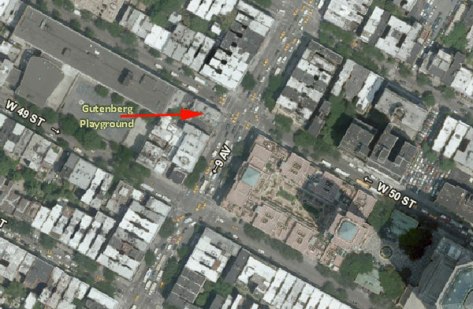
In 1879, a New York Times reporter described a small burial ground that stood at the corner of 9th Avenue and 50th Street in Manhattan:
On the line of the New-York Elevated Railroad is a station commonly known as the “Grave-yard Station.” It is at the junction of Ninth-avenue and Fiftieth-street, and receives its name from a little grave-yard, about 50 feet square, that occupies the south-west corner of the intersecting streets. It is some six feet above the level of the street, and is not much noticed by those on the side-walk, who see nothing but the heavy stone wall surrounding it; but from the platform of the station its handful of gray, crumbling tombstones can be plainly seen, and its forlorn and neglected condition noted. It is bounded on two sides by the streets, on a third by the high blank wall of a store, and on the fourth by a wooden tenement-house, from which a door opens upon it, and to which it makes a convenient front yard. Near this door some of the mounds have been leveled, and a patch of ground a few feet square has been dug up and raked over, so as to form a bit of a garden. Dirty children tumble and play over the other graves, and among the tottering stones, and above all, lines of newly-washed garments are blown about in the wind. No tender recollections appear to cling to the spot, and its appearance is pathetic. As the passenger on the railroad, while waiting for his train, attempts to decipher the almost obliterated inscriptions on the monuments beneath him, and questions the employees of the road, who prove to know as little as himself, he wonders that a place so neglected should be retained for its present uses instead of having been built upon long since, as has every other available plot of ground in the vicinity. He notices that on all of the stones upon which the inscriptions are legible the name is “Hopper” . . .
This burial ground was originally part of the Hopper farm, a large estate that extended from 6th Avenue to the Hudson River between 49th and 54th Streets. Mattias Hopper, the son of Dutch settlers who came to New Amsterdam in 1652, acquired the land in 1714 in the district that was then known as Bloomingdale. Mattias’ son, John Hopper, took possession of the farm around 1750. When John Hopper died in 1778, his will ordered that the farm be divided into six equal portions among his heirs, who entered into an agreement that the family graveyard would be reserved as a burial ground forever. The graveyard continued to be used until 1840, and members of the Hopper, Varian, Cozine, and Horn families were buried there.
In 1846, portions of the graveyard were cut off when 50th Street and 9th Avenue were laid out to the north and east of it and the remains of several individuals were relocated to another part of the cemetery. Buildings rose on the other sides of the property, and the old cemetery was forgotten and neglected. The Hopper farm was famous for a number of 19th century legal battles concerning rights to the estate, including litigation that followed the removal of the burial ground in 1885. Ellsworth L. Striker, a Hopper family descendant who claimed possession of the property, removed the graves and subsequently built an apartment house on the site. Striker’s rights to the property were disputed, but the state Supreme Court eventually decided in his favor. Sources disagree as to whether the remains from the Hopper burial ground were reinterred at Trinity Cemetery in upper Manhattan or at Woodlawn Cemetery in the Bronx.


Sources: “Some Old Grave-yards,” New York Times, May 18, 1879; “The Hopper Burial Place,” New York Herald-Tribune, April 28, 1885, p. 1; Mott, Hopper, Striker (The Historical Co. 1898); The New York of Yesterday: A Descriptive Narrative of Old Bloomingdale (Mott 1908) ; Blackman v. Striker (The New York Supplement Vol 21 1893, 563-565); 1820 Map of Land Belong to the Estate of John Hopper (Abstracts of Farm Titles…Tuttle 1881); Perris’ 1857 Atlases of New York City, Pl. 101; NYCityMap.















